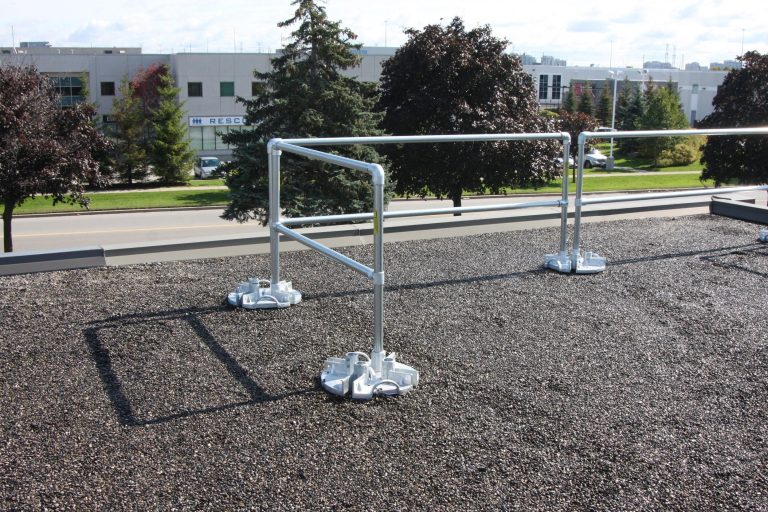According to the Occupational Safety and Health Administration (OSHA), there is a recognized hazard when working on the roof or at heights. Minimizing the dangers of working in such areas starts with a deep-rooted understanding of the risks and deployment of the necessary equipment. There are various reasons why people might be on a roof, especially on a commercial building rooftop. For example, maintenance workers could be inspecting the rooftop air handlers, or there might be project construction workers that need to finish a project. Whatever the reason, the property owner must still be able to protect and ensure the safety of the people who might be on the roof of their building. Take note that falls are one of the most common causes of severe workplace-related deaths and injuries. Fortunately, there are several ways to protect whoever is on your roof. Below are some of the ways to avoid fall-related accidents when on the roof. Fall Protection Guardrails Safety System Items which are not carried or worn like anchor points that protect against the risk of fall is under the fall protection safety system. One of the best examples is the guardrails. Guardrails are a stationary system used to safeguard workers from falls when working at height. This type of fall protection safety system is a preferred means of securing workers because they don’t have to be trained on how to wear, use, and inspect a personal fall protection system (PFPS). High-quality guardrails are a convenient and reliable means of fall protection since they act as a physical and visible barrier. Therefore, this fall protection system prevents falls between levels- from heights, stairwells, balconies, roofs, or open holes. The system is commonly used in many places, such as : warehouses retail shops construction sites shipping facilities industrial settings commercial buildings landscaping settings Handrails and guardrails are often used interchangeably. However, handrails and guardrails are not the same, even though guardrails usually have handrails. Generally, handrails are a handhold for people to support themselves when going either downstairs or upstairs. On the other hand, guardrails are specifically designed to prevent falls around the hazard areas. The OSHA has imposed regulations for when guardrails should be installed and specifications for how they must be implemented. By law, building owners or employers should comply with all regulations concerning fall hazards in the workplace provided by the OSHA. Moreover, this fall protection system must be used when people have access to unsecured edges of the following surfaces: Open edges of slab formwork for roofs and floors Around a mezzanine or balcony Around open platforms, raised platforms, or scaffolds Around elevated work surfaces If you are looking for a guardrail that can be installed temporarily, opt for a free-standing, portable, and OSHA compliant mobile roof safety rails. This safety guardrail is non-penetrating and meets the OSHA fall protection standards. Personal Fall Protection Equipment Items that are carried or worn, which protect users from falling, are under the category of personal fall protection equipment (PFPE). There are three PFPE types and methods currently of use. Each equipment focuses on a different risk level and work situation. The first type is called the travel restraint PFPE. It restricts or limits access to locations where a fall can take place. This restrictive PFPE is designed to prevent accidents such as falls. Travel restraint PFPE consists of the following: Anchor Rope Grab Lifeline or Lanyard Full Harness Make sure to pick an anchor that’ll fully support the force of the load. Also, it must be positioned correctly. Before you use the travel restraint PFPE, do the following: Determine all fall hazards in the area. Choose the right components like a snap hook, self-retracting lifeline, energy absorbers, and Y-lanyard. Find suitable anchor points. For example, an anchor point that is almost perpendicular to the hazard area. Ensure that a competent person inspects the equipment before and after use. If a single component of the travel restraint system is not working, that part should be removed immediately. The second type of PFPE is called the positioning PFPE, which enables the partial or total suspension of a worker. It is typically used to protect workers when climbing ladders, allowing them to work without using their hands to support them. The third type is called personal fall arrest systems (PFAS). This equipment isn’t designed to prevent falls from happening but stops the worker’s free fall from a working-walking surface. PFAS consists of self-retracting lifelines, personal fall limiters, connecting devices, and a full-body harness. Regardless of the type of equipment or method use, PFPS must be designed by an experienced and qualified person. An analysis or examination of the supporting structure must also be practiced. Quality Inspection There are several things to consider when examining fall protection systems and personal protection equipment. Has a fall protection system been correctly installed within the guidelines of the manufacturer? Are the calculations accurate to ensure safe load levels? Has it been constructed properly with the correct components? If the answers to these questions are no, then workers working at height may be in danger. Therefore, some problems that quality inspection must cover include: Signs of corrosion Checking damages in cables Energy absorbers inspection Inspection of harnesses and lanyards for cuts and breaks Re-tensioning of cables Checking damages to fittings Quality Training Although safety for people working at heights sits with the employer or building owner, the worker themselves must take responsibility for their safety. However, most of them lack the proper training or knowledge required to correctly identify whether a fall protection system or PFPE is safe to use. Failure in doing so could lead to severe injuries, or worse, death. Thus, quality training is imperative and is always the best form of protection. Takeaway Quality training, regular quality inspection, and the right equipment are essential. However, all count for nothing without the required safety methods and risk assessments considered in place. That said, all equipment must go through pre-checks. Consider hiring an external company





